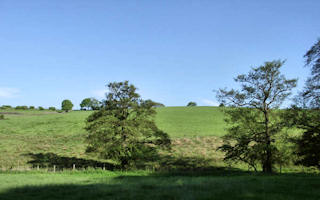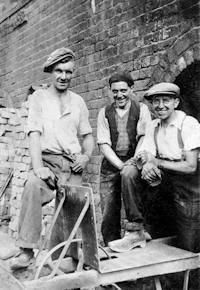The Mining Industry
There were a few slag heaps left blotting the Mirfield landscape in the wake of the mining industry that had once flourished in Mirfield. When I moved to the Kitson Hill Estate in 1948 the King's Head pit was closed down but the mine shaft and the shaft-head building were still there along with its slag heap which was higher than the roofs of the neighbouring houses at Cripple Gate. The shaft of this mine was sunk in 1891 and connected with existing workings at the Dark Lane mine. The mining company stopped trading in 1931 partly due to a constant battle with water entering the workings. I shudder now to think that we used to play around the shaft head building and sometimes even inside it. I remember there was a lot of rubble inside that formed a slope to the shaft into which we threw stones to hear them splash into the water a long way below. One false step and we could have have slipped on the rubble and gone over the edge to meet our fate. We mainly played on the slag heap climbing up it and then running down, or in winter we would sledge down it. At other times of the year we would use it as a run for our trolleys made from planks of wood and old pram wheels. It was maybe a couple of years later that the slag heap was levelled, the building was demolished and the shaft sealed. Lionel Padget had Waterroyd Garage built on the site and this traded as a motor repair shop and showroom for many years. This was more recently home to a Plant and Tool Hire company but has now been demolished and an apartment block built on the site. In the second half of the 1960s a row of six semi-detached houses was built over the lower part of the site where the slag heap had previously stood.

Gregory Springs area
The largest slag heap I remember was at Cuckow Hill which was the residue from the Gregory Springs mine (we always called it Cuckoo Hill but cuckow is an old word meaning waste). This was served by a narrow rail track from the mine at Hagg Lane and I recollect seeing small trucks plying up and down the track carrying the waste products to the heap. This slag heap was rich in fossils and we used to scramble over its slopes searching for them and carrying them home with us like treasure. This was a much larger heap than the one at Kings Head and I believe that it was not levelled and landscaped until the mid to late 1960s. The picture on the left is how Cuckow Hill looks today after the heap has been removed and grassed over. Seeing this view, it is hard to imagine how it looked with a gigantic, grey mound rising from the middle of this pleasant scene. It is only recently that I discovered that the brother of my wife's Great Grandmother died in this mine. His death certificate reads: 15 December 1880, John William Ellam, 21 years, Cause of death: Fall of Stone from roof upon him while at work in the Black Bed of Coal, Instant death.
There had been a day hole at Foxroyd where the air raid shelter was later constructed but I have no recollection of this myself. There were workings and a slag heap around Cravendale Road and Nevins Road at the Ravensthorpe end of the church fields, which were part of the Dark Lane Colliery. The slag heap was in between the bowling greens and the old railway line. We used to walk down the side of the Parish church, following the path through the fields with its hedgerows and blackberry bushes, then go under the railway by a low tunnel and climb or skirt around the slag heap. We would then go on passed the bowling greens and pavilion to a football field and a recreation ground before coming out in Ravensthorpe.
I remember that there was a spring at the other side of the church arising in a field below the graveyard. This stream is still there today and is the reason why the graveyard cannot be extended below its present position resulting in an acute shortage of graves. It runs across the fields and I remember it being thick with watercress. It continued onward to join the path at the tunnel under the railway where it went through a culvert but this was often blocked so that it spilled over onto the path. Across the field where the spring rises was the cutting of the railway carrying the Leeds New Line but this has now been filled in and a small estate of private houses built on it. A wooden footbridge crossed the cutting and had gate-styles at either end to keep the cows off it. The footpath then continued and ran out at the top of Shillbank Lane, emerging at the side of Longstaff's house right where Paper Hall once stood.
Garforth's Taylor Hall Brickworks

Workers at Garforth's Brickworks
Garforth's quarry and brickworks was situated on Taylor Hall Lane and had a working brick kiln. An earlier brickworks on Old Bank Road, identified on a 1905 map as Crown Point Brick Works, was no longer working and just comprised a series of ponds which were the flooded bottoms of the old quarries and we would find newts and salamanders there.
During my lifetime, Taylor Hall Brickworks was owned by two brothers, Tom and Norman Garforth. Tom was the elder brother who ran company and Norman was the younger brother. Norman used to help out when needed and lived at West Royd House which is now the Christadelphian Shelter on Water Royd Lane.
Norman had a daughter called Jackie who was about my own age.
Following the closure of the works the site of the quarry has been used for landfill and the lower part, where the offices and kiln were, has subsequently been built on.